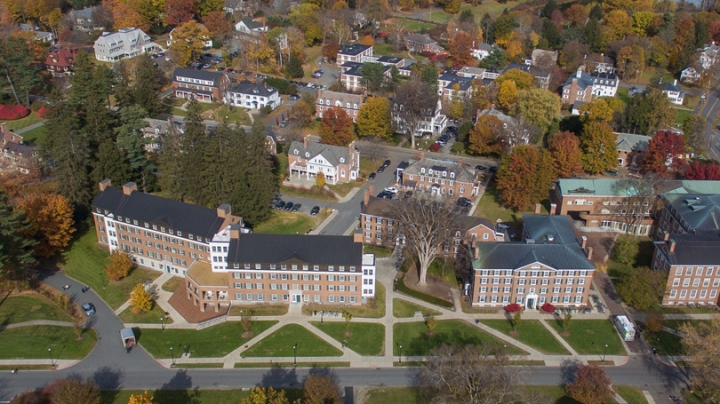Editor’s note: Since this article was published, Associate Professor Ryan Calsbeek and Associate Professor Jane Hill have stepped down from their roles as house professors. Associate Professor Janice McCabe now serves as house professor for Allen House, and Associate Professor Melanie Taylor is the North Park professor.
The College has designated the six new house communities that will provide permanent home bases for all Dartmouth undergraduates beginning in the fall of 2016.
“This is a great step forward for Dartmouth,” says Dean of the College Rebecca Biron, who is overseeing the transition to the house system. “The house communities are based on the simple premise that successful learning requires strong community bonds. The houses will provide more opportunities for intellectual engagement through social encounters among students, faculty, and staff.”
The new residential life model, a cornerstone of the Moving Dartmouth Forward plan, is designed to transform the undergraduate living experience, bringing more continuity to students’ on-campus living experiences and presenting greater opportunity for faculty-student interaction beyond the classroom.
In May, six faculty members were appointed house professors. They will live in single family homes assigned to each of the six house communities. A seventh professor will serve as faculty director of the McLaughlin Cluster, where the living learning communities will be located. The house professors are serving a four-year term, which began on July 1.
The house professors and their families will live in a College residence within a short walk of their house community. Below are the names of the new communities and the groups of residence halls that make up each house. (The house community names may change in recognition of gifts to further enhance the house programs.)
- Allen House: Gile, Streeter, and Lord halls; Thayer School of Engineering Associate Professor Jane Hill will live in a residence being built on Allen Street.
- East Wheelock House: Andres, Zimmerman, McCulloch, and Morton halls; Associate Professor of Mathematics Sergi Elizalde will continue to live on East Wheelock Street.
- North Park House: Ripley, Woodward, and Smith halls; Associate Professor of Biological Sciences Ryan Calsbeek will live on North Park Street.
- School House: Massachusetts Row and Hitchcock Hall; Associate Professor of Mathematics Craig Sutton will live in a new residence being built on School Street.
- South House: Topliff, New Hampshire, and the Lodge; Professor of Sociology Kathryn Lively will live on Sanborn Street.
- West House: Fahey, McLane, Butterfield, and Russell Sage halls; Assistant Professor of Physics and Astronomy Ryan Hickox will live in a residence being built on Webster Avenue.
- Living Learning Communities: Dennis Washburn, the Jane and Raphael Bernstein Professor in Asian Studies, will live on Clement Road and will lead the living learning communities based in the McLaughlin Cluster and work closely with the eight academic affinity communities located in other buildings, such as the Chinese Language House, Sustainable Living Center, and LALACs House. All students in the living learning communities, which include the affinity communities, will also be assigned to one of the six house communities.
Transitioning Into the House System
In February 2016, students who are not graduating in June will receive notification of their randomly assigned membership in one of six houses. Each of the six house communities will have up to 700 members, so current students will know many of those who have been assigned to the same house.
This month, all students who will return in fall 2016 will be invited to identify one to five students with whom they would like to share a house community.
“For this transition year only, we are giving returning students the chance to enter into their new house community along with a small group of friends if they so wish,” Biron says.
Members of the Class of 2020 will be the first to experience the house system for their entire time at Dartmouth. All incoming ’20s will be informed of their house memberships in July of 2016 when they receive their first-year room assignments. (See timeline, below.)
Lively, the house professor for South House, notes that students say that the residential turnover associated with the D-Plan makes maintaining long-term connections to a community of friends difficult. The new house plan will address that difficulty by providing a home base for students throughout their time at Dartmouth, Lively says.
In addition, it will provide the setting to enable students to better integrate their social, academic, and creative lives. The house system will offer many opportunities for students to interact socially and intellectually with faculty, artists, professional leaders, and the wider community, Lively says.
It is also a chance for the students who lead the way into the new system “to imagine how they want to define their college culture,” she says.
Adapting and Establishing Traditions
Under the new system, incoming first-year students will be assigned to a house community but will continue to live in residence halls designated as first-year housing. In these halls, they will live with other first-year members of their house communities and with upperclass undergraduate advisers (UGAs). Biron says the arrangement aims to promote class bonding and participation in residential education programs.
The first-year buildings will be French and Judge halls in the River cluster, the Choates, the Fayerweathers, and Richardson and Wheeler halls. Some first-year students will also live in East Wheelock and in the McLaughlin Cluster.
Students will continue to have other choices within the residential system—including living learning communities, academic affinity programs, senior apartments, Greek letter organizations and societies, and off-campus apartments—while maintaining the affiliation with their house community.
Discussions about residential improvements began several years ago during visits to other institutions by staff and students. After President Phil Hanlon’s Moving Dartmouth Forward announcement in late January, a student advisory committee was formed to envision features of a housing system that would promote a greater sense of community. This fall, Biron invited all students to join in the planning through three fall-term working groups made up of house professors, students, and staff.
The groups are recommending frameworks for student leadership within the house communities and ways to involve faculty, graduate, and professional school students in house activities. One of the working groups is developing ideas for events for late winter and spring to kick off the house system with current students once they are notified of their house memberships.
Noah Manning ’17 is a student member of the house system working group. He says that next fall, when students first join their new house communities, they will be part of defining the unique character and traditions of their house.
“That’s the most exciting thing about this. It’s a tabula rasa. We can make it what we want,” Manning says. “Because Dartmouth is a place of such great tradition, to have the chance to make a tradition from scratch is really exciting. Someone must have built the first homecoming bonfire, and it caught on. I can imagine coming back as an alum in 50 years and being able to say, ‘I helped found this.’ ”
Students interested in getting involved in planning this winter and in joining house-specific discussions in the spring will have many opportunities to participate. Alumni discussed exploring ways in which they can participate in house programming during a session they had with Biron and Vice Provost for Student Affairs Inge-Lise Ameer at the Alumni Council meeting on Oct. 22-24.
Creating New Spaces
Each house community will have a programming budget to support activities, including inter-house athletics, arts events, and service opportunities, house dinners, field trips, speakers, performances, and social gatherings. Some existing social spaces in residence halls will be refurbished and two temporary structures will provide “living room” spaces for the house communities. The temporary structures are expected to be ready for use by August 2016.
One of the temporary structures will be constructed in the area between Gile and Hitchcock halls and will serve the Allen and School house communities. The modular building will provide open space on two floors, a snack bar, and a landscaped outdoor public area. The building is expected to be in place by August 2016.
The second temporary building—called a Sprung Structure—will be constructed on the two tennis courts closest to Memorial Field on Crosby Street, adjacent to West Gymnasium. The three tennis courts closest to East Wheelock Street will remain.
Sprung structures are made from fabric membranes stretched over a metal frame. Harvard Business School has been using such a structure as an executive education dining center for several years during construction of a new building. The Dartmouth Sprung structure will provide new living room space for the South and North Park house communities.
The Campus Services planning team will review plans for the temporary structure that will be assigned to the Allen and School communities with the town of Hanover’s Planning Board at a public hearing scheduled for Nov. 3. The structure needs board approval.
“This is a collective effort,” Biron says. “These house communities will enrich the Dartmouth experience for everyone.”
House Community Timeline
November-December 2015: First-year students, sophomores, and juniors identify one to five students with whom they hope to be in the same house community. Campus Services planners review temporary structure attached to Allen House and School House communities with town of Hanover Planning Board.
February 2016: Students who are not graduating in June receive their house memberships. Community celebrations will take place.
Winter/spring 2016: House professors, students, and staff plan events and activities for house community members. House-specific working groups and house professors develop programs for the 2016-17 academic year.
July 2016: Incoming members of the Class of 2020 receive house memberships along with first-year room assignments. House professors move into College residences.
August 2016: Two temporary facilities are expected to be ready for use.
Fall 2016: House communities open.

